Expressionism Art – Expressionist Movement Characteristics
Expressionism is a modernist art trend that materialized in the early 20th century, mostly in Germany and Austria. Characterized by its vivid and emotionally charged style, Expressionism sought to depict the world from a subjective perspective, often distorting reality to convey the inner experiences and emotions of the artist. In this article, we will delve into the origins and development of Expressionism art, examining its key characteristics, notable artists and artworks, and its lasting impact on the art world.
Contents
- 1 Expressionist Art: Expressionism Art and Its Origins
- 2 History of Expressionism Art: The Expressionism Years
- 3 A Brief Overview of Notable Expressionist Artists
- 4 Characteristics of Expressionism Art: What Is Expressionism?
- 5 Different Types of Expressionism Art: Expressionism Art Definitions
- 6 Deep Dive Into Notable Expressionism Artworks
- 7 Frequently Asked Questions
Expressionist Art: Expressionism Art and Its Origins
Expressionism is an artistic style that emerged in Germany at the beginning of the 20th century, characterized by intense emotional expression and a rejection of traditional artistic conventions. Expressionist artists sought to create works that expressed their innermost feelings and emotions, often using vivid colors, bold brushstrokes, and distorted forms. The origins of Expressionism art can be traced back to the late 19th century when creatives started to challenge the dominant academic styles of painting and sculpture. These expressionist painters sought to break free from traditional techniques and subject matter and explore new forms of artistic expression.

One of the key influences on Expressionism was the work of the French painter Paul Cézanne (1839 – 1906), who rejected the traditional rules of perspective and created works that emphasized the two-dimensional surface of the canvas. Other important influences on Expressionism include the works of Vincent van Gogh (1853 – 1890), Edvard Munch (1863 – 1944), and the Fauvist movement.
One of the most famous Expressionist groups was Die Brücke (The Bridge), founded in 1905 by a group of young artists in Dresden.
The group sought to create a new form of artistic expression that was free from the constraints of tradition, and their work had a profound influence on the development of Expressionism in Germany and beyond. Overall, Expressionism was a highly influential art movement that sought to challenge traditional artistic conventions and to create works that expressed the innermost feelings and emotions of the artist. This artistic campaign had a substantial effect on the evolution of modern art and continues to inspire artists and audiences today.
The Importance of Expressionism Art in the Art World
One of the key contributions of Expressionism to the art world was its emphasis on subjectivity and individual experience. Expressionist artists were interested in exploring the inner realm of the artist, and in conveying a sense of emotional power and upheaval in their work. This approach to artmaking was in stark contrast to the dominant artistic conventions of the time, which emphasized objective observation and representation.
The Expressionist movement also had a noteworthy impact on the expansion of modern art. The movement paved the way for other avant-garde artistic styles, such as Surrealism and Abstract Expressionism, which also sought to challenge traditional artistic conventions and explore new forms of artistic expression.
Expressionism also played an important role in the development of modernist architecture, particularly in the work of the German architect, Walter Gropius (1883-1969). Gropius, who founded the influential Bauhaus school of design in 1919, was deeply influenced by the Expressionist movement and sought to create a new form of architecture that was in harmony with the emotional and psychological needs of modern society. Besides its effect on the visual arts, Expressionism also had a significant influence on literature, music, and film. The Expressionist movement inspired a new generation of writers, musicians, and filmmakers, who sought to create works that conveyed a sense of emotional intensity and inner experience.
History of Expressionism Art: The Expressionism Years
Now that we have established the background and importance of the Expressionist movement, we will take a closer look at the history of Expressionist art, how Fauvism contributed to the start of this art movement, and what happened in Germany that gave rise to German Expressionism art. We will also look at a few expressionist painters that contributed to the movement’s oeuvre.
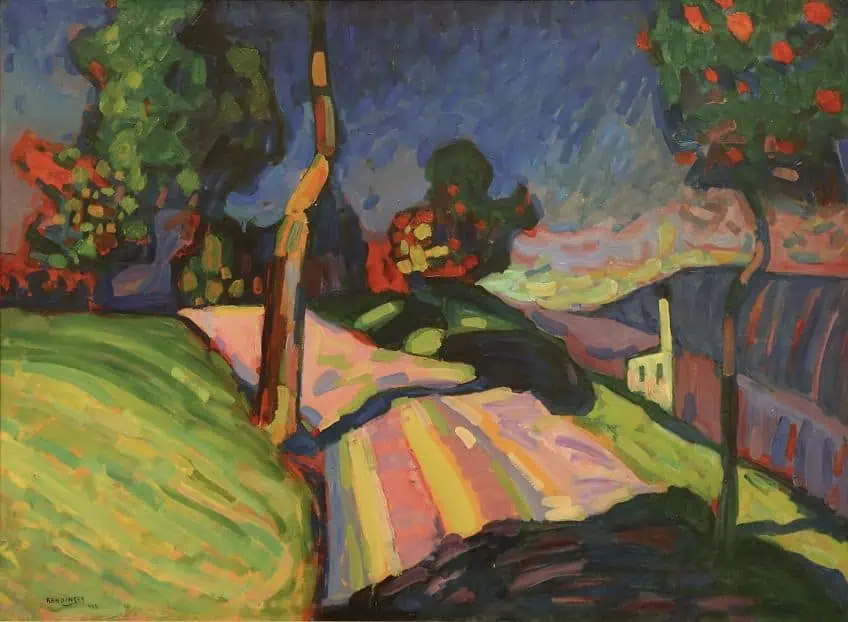
Fauvism as a Catalyst
Fauvism and Expressionism were two important art movements that emerged in the early 20th century, and their development was deeply interconnected. While Fauvism was marked by its bright, bold colors and expressive brushwork, Expressionism was characterized by a deep exploration of emotion and the psyche. This section of the article will explore how Fauvism influenced Expressionism and how the two movements differed.
Fauvism emerged in France in the early 1900s, and it was led by artists such as Henri Matisse (1869 – 1954), André Derain (1880 – 1954), and Maurice de Vlaminck (1876 – 1958). The Fauves, as they were called, rejected the traditional rules of painting and instead focused on the expressive potential of color. They used bright, bold colors that were often placed side by side without blending, creating a sense of dynamism and movement in their works.
This emphasis on color and emotion was a radical departure from the academic tradition, and it quickly gained popularity among younger artists.
Expressionism, on the other hand, emerged in Germany in the same period, and it was marked by a deep exploration of human emotion and the psyche. Expressionist artists such as Ernst Ludwig Kirchner (1880 – 1938), Emil Nolde (1867 – 1956), and Wassily Kandinsky (1866 – 1944) sought to express the inner emotional experiences of their subjects, often using exaggerated or distorted forms and vivid, intense colors. Like the Fauves, Expressionists rejected traditional forms and techniques, but their focus was on exploring the depths of human emotion and the unconscious mind.
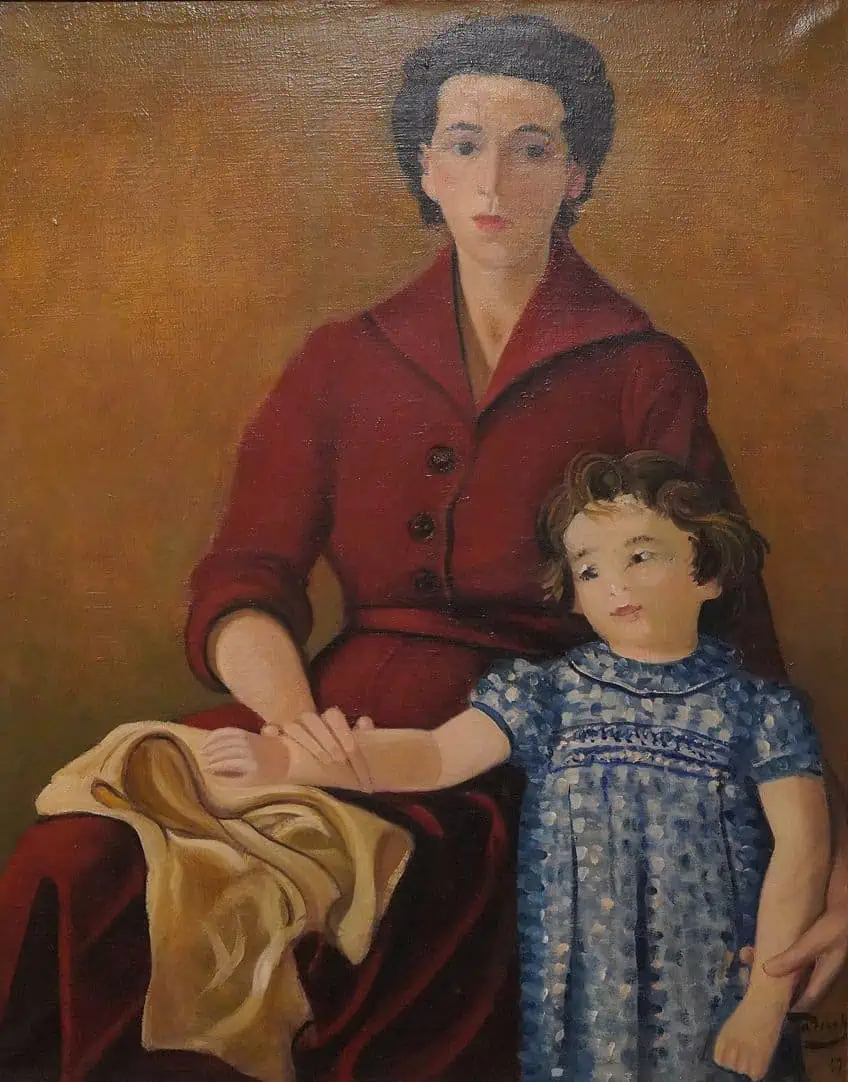
Despite these differences, Fauvism had a powerful influence on the growth of Expressionism. Fauvist artists were some of the first to embrace the expressive potential of color, and they paved the way for Expressionists to use color as a tool for exploring the depths of human emotion.
Many Expressionist artists also shared the Fauves’ rejection of traditional forms and techniques, preferring to experiment with new styles and methods to express their ideas.
One key difference between the two movements was their subject matter. Fauvism tended to focus on landscapes and still lifes, while Expressionism was more concerned with the human figure and the psychological states that lay beneath the surface. Fauvist paintings were often characterized by a sense of joy and spontaneity, while Expressionist works could be dark, anguished, and even disturbing. Another key difference was their use of form. Fauvism was marked by its use of bold, sweeping brushstrokes and loose, gestural forms, while Expressionism often used more exaggerated, distorted forms to convey a sense of emotional intensity. Expressionists were also more likely to use thick, impastoed paint to create a sense of texture and depth.
The Movement’s Origins in Germany
In this section of the article, we will take a closer look at what led to German Expressionism art, focusing on the art movements that precede it, the socio-political context that gave birth to it, and significant Expressionist painters from Germany.
Art Movements That Preceded German Expressionism Art
The precursor to Expressionism was the Jugendstil (youth style), also known as Art Nouveau, a decorative art movement that flourished in Germany and Austria in the late 19th and early 20th centuries. Jugendstil artists used ornamental motifs inspired by natural forms, such as flowers and flowing lines. They were also known for their stylized typography and graphic design. One of the catalysts for the emergence of Expressionism was the work of the Brücke (Bridge) group, founded in 1905 by a group of young artists in Dresden.
The Brücke artists rejected the traditional academic style and instead explored new ways of representing the human form and the world around them. They sought to capture the raw emotions and energy of life through vivid colors, bold brushstrokes, and distorted forms.
Another group that played a significant role in the development of Expressionism was the Blaue Reiter (Blue Rider) group, founded in 1911 in Munich by Wassily Kandinsky and Franz Marc (1880-1916). The Blaue Reiter artists sought to transcend traditional representational art and explore the spiritual and mystical dimensions of the human experience. They used bright colors, abstract forms, and symbolism to convey their ideas.
The German Socio-Political Context
German Expressionism emerged in the early 20th century, during a tumultuous period in German history marked by rapid social, economic, and political change. The movement was deeply influenced by the cultural and intellectual currents of the time, as well as the broader social and political context in which it emerged. At the turn of the century, Germany was undergoing a period of rapid modernization and industrialization. The country had become a major player in the global economy, and its cities were rapidly expanding. This process of modernization brought with it new social, economic, and cultural tensions, as traditional ways of life were uprooted and replaced by new forms of urban living.

At the same time, Germany was experiencing a profound intellectual and cultural ferment. The country was home to some of the most innovative and influential thinkers of the age, including Sigmund Freud (1856 – 1939), Friedrich Nietzsche (1844 – 1900), and Karl Marx (1818 – 1883). These thinkers were grappling with fundamental questions about the nature of human experience and the role of the individual in society, and their ideas had a profound impact on the artists and writers of the time.
Against this backdrop, German Expressionism emerged as a deeply ambivalent response to the cultural and political changes of the day. On the one hand, Expressionist artists were deeply critical of the emerging capitalist order, which they saw as cold, dehumanizing, and spiritually bankrupt. They rejected the dominant culture of consumerism and conformity, and sought to create a new kind of art that would be more authentic, more emotive, and more spiritually meaningful.
At the same time, however, Expressionist artists were deeply ambivalent about the nature of modernity itself.
They were acutely aware of the ways in which modern society had fragmented and alienated the individual, and they sought to create art that would help to heal this rupture. But they were also deeply skeptical of the idea of progress, and of the notion that modernity could be a force for good in the world. Many Expressionist artists were drawn to the idea of primitivism, and to the notion that traditional, pre-modern societies might hold the key to a more authentic and fulfilling way of life.
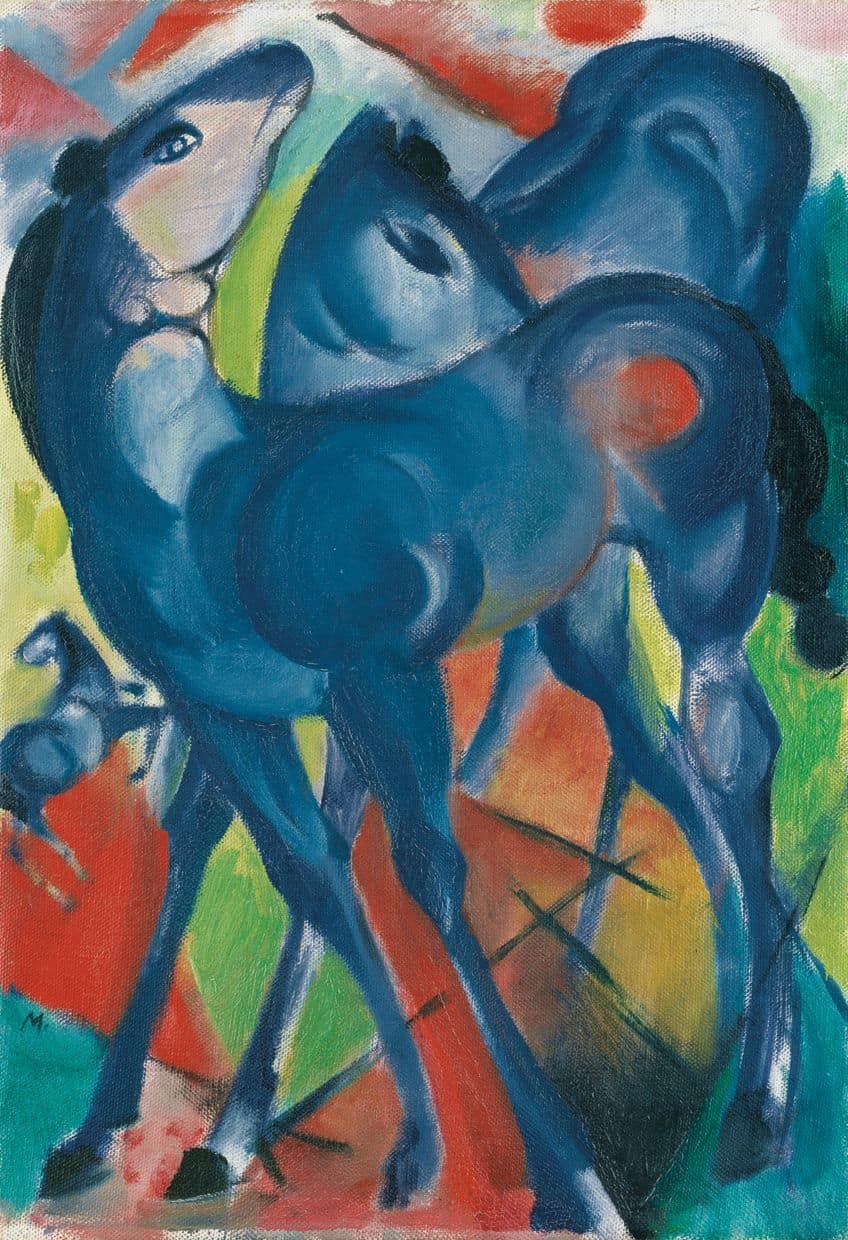
These complex and ambivalent attitudes were deeply shaped by the political and social context in which Expressionism emerged. Germany was experiencing a period of rapid political change, as the country moved from a monarchical system to a democratic one. This process was marked by intense political polarization, as different groups jostled for power and influence in the new order. Expressionist artists were deeply engaged in these debates, and many saw themselves as radical critics of the existing political order.
Some artists were drawn to left-wing political movements like socialism and communism, while others were drawn to more nationalist and conservative movements.
Overall, German Expressionism was deeply rooted in the social, economic, and political context of its time. It emerged as a complex and ambivalent response to the challenges of modernity and was deeply influenced by the cultural and intellectual currents of the day. Today, the movement remains a powerful and enduring testament to the power of art to engage with and respond to the social and political challenges of its time.
Reception of German Expressionism Art
Expressionism was met with mixed reactions when it first emerged. Some critics dismissed it as crude and unsophisticated, while others praised its boldness and vitality. Nevertheless, Expressionism soon gained popularity and acceptance, with its impact felt across various art forms, including painting, sculpture, literature, music, and film. The acceptance of Expressionism was aided by the fact that it reflected the changing social and political climate of the time. Its emphasis on individuality, emotion, and subjectivity resonated with the growing interest in self-expression and the rejection of traditional values.
Moreover, Expressionism’s rejection of traditional aesthetics and embrace of new forms and styles paved the way for further experimentation and innovation in the art world.
A Brief Overview of Notable Expressionist Artists
Even though Expressionism art started in Germany, it did not stay contained very long. In this section, we will first look at significant German Expressionist artists, and then at Expressionism in the larger context of the world – zooming in on important Expressionist artists outside of Germany.
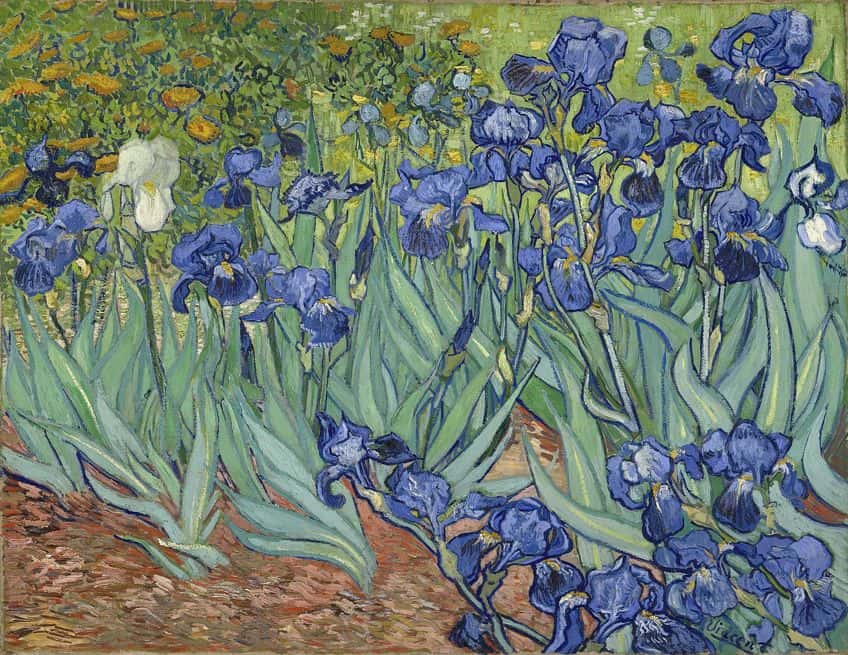
German Expressionist Artist: Ernst Ludwig Kirchner
Ernst Ludwig Kirchner (1880 – 1938) was a German Expressionist painter and printmaker, known for his vivid, colorful works that captured the energy and intensity of modern life. Born in Aschaffenburg, Germany, Kirchner studied art in Munich before moving to Dresden, where he co-founded the influential art group Die Brücke (The Bridge) with a group of like-minded artists.
Kirchner’s early works were characterized by their bold, expressive use of color and their interest in the human figure, particularly the female form. He often depicted dancers, acrobats, and other performers in frenzied, dynamic poses, using thick, gestural brushstrokes to capture their movements and energy.
Kirchner was also deeply interested in the cultural and intellectual currents of his time, and his work often reflects his engagement with the ideas of thinkers such as Nietzsche, Freud, and Marx. He was particularly interested in the tension between the individual and society, and many of his works depict the alienation and fragmentation of modern life. In addition to his paintings, Kirchner was a prolific printmaker, creating woodcuts and lithographs that were just as expressive and vibrant as his paintings. His printmaking helped to popularize Expressionism, making it accessible to a wider audience and cementing Kirchner’s reputation as one of the most important artists of the movement.
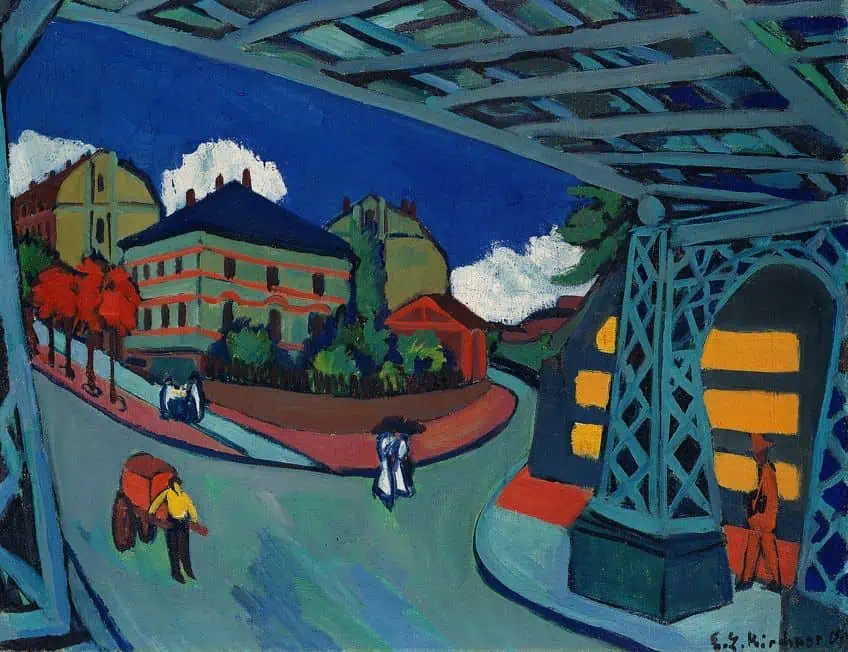
Kirchner’s work had a profound impact on the development of modern art, influencing a generation of artists both in Germany and around the world. His use of bold, expressive color and his interest in the human figure helped to pave the way for the development of Abstract Expressionism in the United States, while his focus on the individual and the psychological aspects of modern life anticipated many of the themes that would come to define 20th-century art. Today, Kirchner’s work remains an enduring testament to the power of art to engage with and respond to the complex social and cultural forces of its time.
Dutch Expressionist Artist: Vincent van Gogh
Vincent van Gogh was a Dutch post-impressionist painter and one of the most famous artists associated with the Expressionism movement. His unique style of painting and use of vivid, expressive colors helped pave the way for the development of Expressionism in the early 20th century. Van Gogh’s contribution to Expressionism can be seen in his emphasis on the emotional and psychological aspects of his subjects. He often used bold brushstrokes and vibrant colors to convey intense emotions and to capture the essence of his subjects’ inner lives.
His work also focused on the beauty and majesty of nature and the human form, celebrating the power and wonder of the natural world.
Some of Van Gogh’s most notable paintings, that are characterized under the Expressionism art movement, include Starry Night (1889), The Bedroom (1888), Sunflowers (1888), The Night Café (1888), and Irises (1889). These paintings are characterized by their use of vivid, bold colors, expressive brushwork, and distorted forms, all hallmarks of the Expressionism style. They also convey a deep sense of emotion and the power of the natural world, which were central themes in Van Gogh’s work.
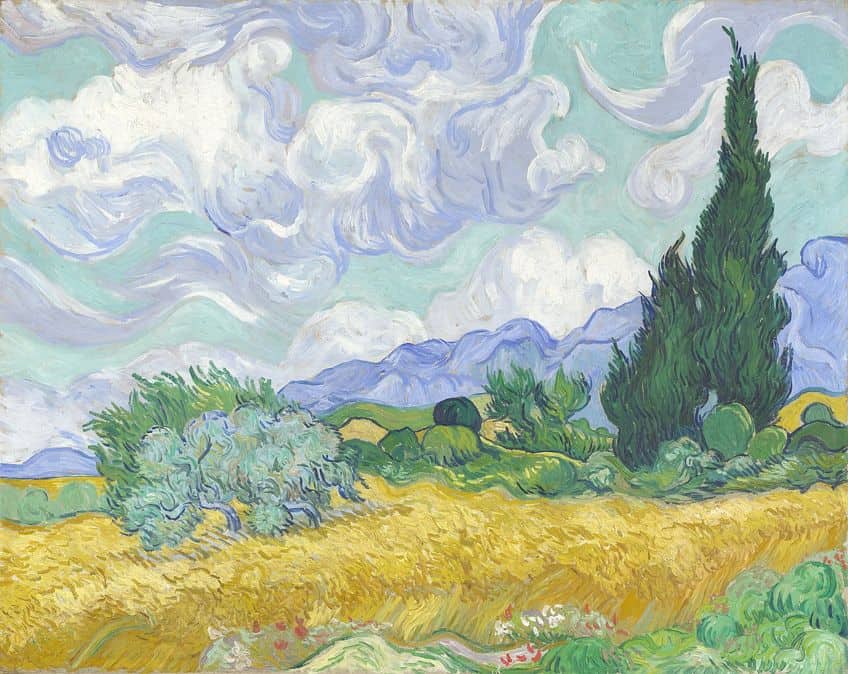
Van Gogh’s influence on the Expressionism movement cannot be overstated. His unique style and approach to painting helped pave the way for other Expressionist artists to explore new forms and styles of expression. Today, Van Gogh is widely regarded as one of the most important and influential artists of the modern era, and his contributions to the development of Expressionism are a significant part of his legacy.
Norwegian Expressionist Artist: Edvard Munch
Edvard Munch was a Norwegian painter and printmaker who is widely regarded as one of the most important figures in the development of Expressionism. His work was characterized by its intense emotional expression, use of vivid colors and bold brushwork, and focus on the psychological and emotional states of his subjects.
Munch’s contribution to Expressionism was significant in that he helped to popularize the movement and bring it to a wider audience. His paintings and prints were widely exhibited throughout Europe and America, and his work helped to establish the Expressionism movement as a major force in the art world.
Some of Munch’s most notable paintings, that are characterized under the Expressionism art movement, include The Scream (1893), Madonna (1895), Melancholy (1891), The Dance of Life (1899-1900), and Ashes (1894). These paintings are characterized by their use of bold, expressive brushwork, and intense emotional expression, which were hallmarks of the Expressionism style. They also convey a deep sense of psychological and emotional turmoil, which were central themes in Munch’s work.

Russian Expressionist Artist: Wassily Kandinsky
Wassily Kandinsky (1866 – 1944) was a Russian-born painter and art theorist who is often regarded as one of the pioneers of abstract art and a leading figure in the Expressionist movement. Kandinsky’s early works were representational, but in the early 20th century, he turned towards abstraction, developing his own unique style that would come to define the movement.
Kandinsky’s contribution to Expressionism lies in his pioneering use of color and form to express emotions and ideas, rather than simply representing the physical world.
He believed that art should be more than just an imitation of reality, and that it had the power to evoke deep feelings and spiritual experiences in the viewer. Some of Kandinsky’s most notable paintings, that are characterized under the Expressionism art movement, include Composition VII (1913), Improvisation 28 (1912), Yellow-Red-Blue (1925), and Composition VIII (1923).
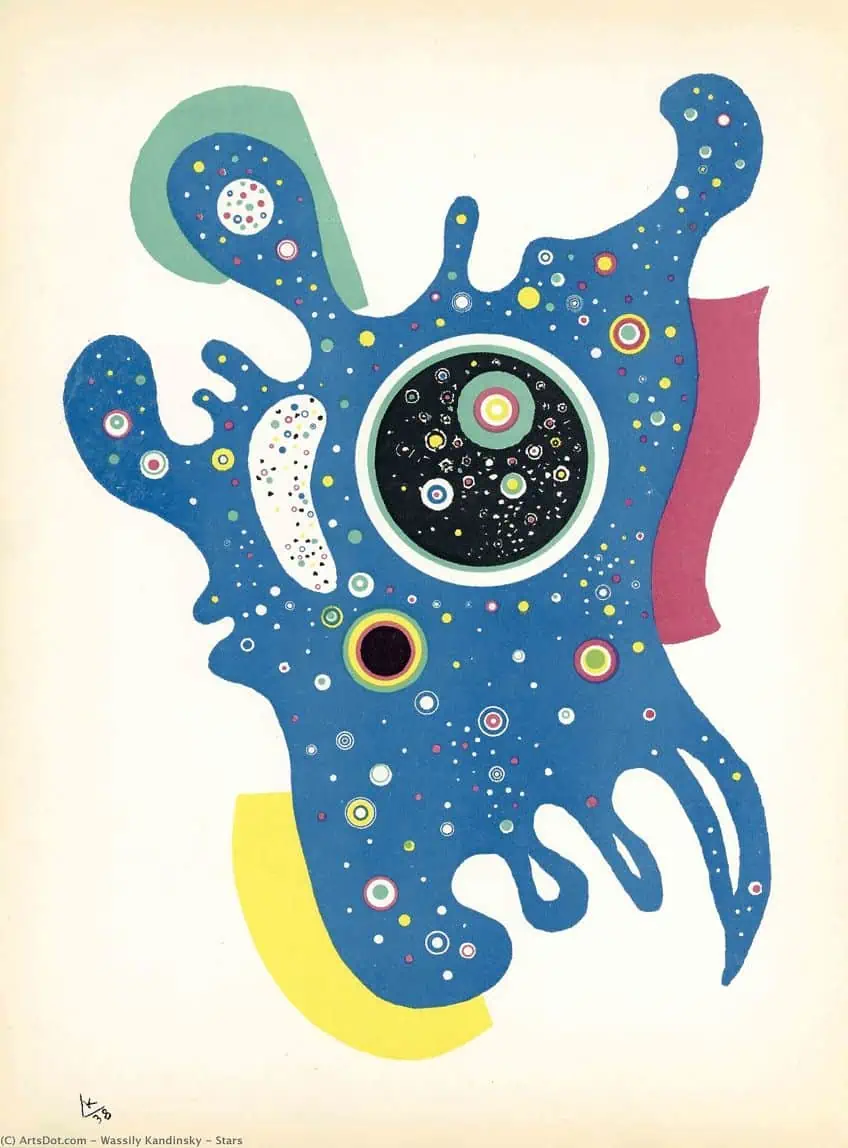
Characteristics of Expressionism Art: What Is Expressionism?
The Expressionist movement is characterized by a focus on subjective feelings and internal experiences, rather than external reality. Even though this is a very subjective, and therefore, narrow artistic lens, there are still elements of expressionist paintings that bind them together. Let us look at the key characteristics of expressionist art, including bold colors, distorted shapes, and exaggerated emotions.
Bold Colors and Distorted shapes
Expressionist artists use vivid, intense colors to create a sense of emotional intensity and drama. They often employ stark contrasts between complementary colors, such as red and green, to heighten the emotional impact of their work. Expressionist artists distort or exaggerate forms and shapes to express inner feelings and ideas.
This can include elongated figures, twisted or contorted shapes, and distorted perspectives.
Exaggerated Emotions and Subjectivity
Expressionist art often features exaggerated or intense emotions, such as fear, anxiety, anger, and passion. This can be conveyed through facial expressions, body language, and symbolic imagery. Expressionist artists also focus on subjective experience, using their art to express their own personal emotions and ideas. They often reject objective reality in favor of their own emotional responses to the world.
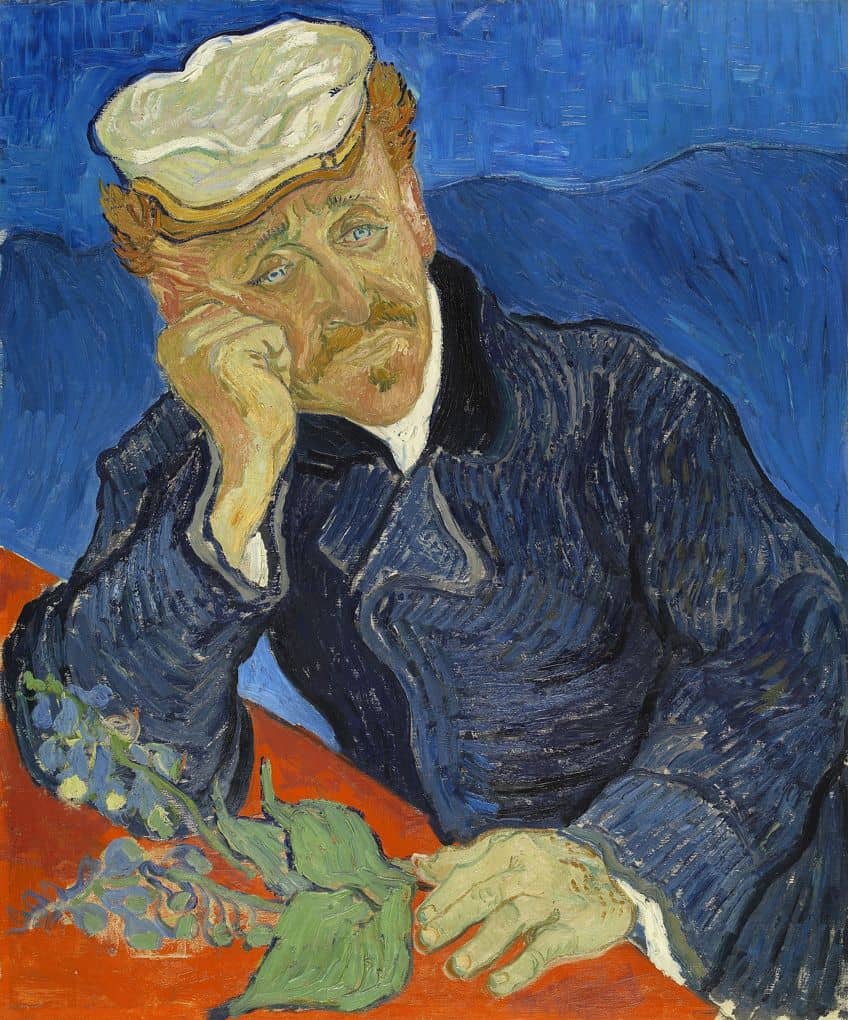
Primitivism and Symbolism
Many expressionist artists were influenced by the art of non-Western cultures, particularly African and Oceanic art. They sought to capture the simplicity and directness of these works, often incorporating elements of primitivism into their own art. Expressionist art often uses symbolic imagery to convey abstract ideas and emotions.
These symbols may be personal or cultural and can include religious imagery, dream symbolism, and other abstract motifs.
Different Types of Expressionism Art: Expressionism Art Definitions
Over time, the Expressionism art movement has evolved and given rise to a number of different types of expressionist art, each with its own unique characteristics and influences. Let us discuss some of the Expressionism art definitions for the most prominent types of expressionist art.
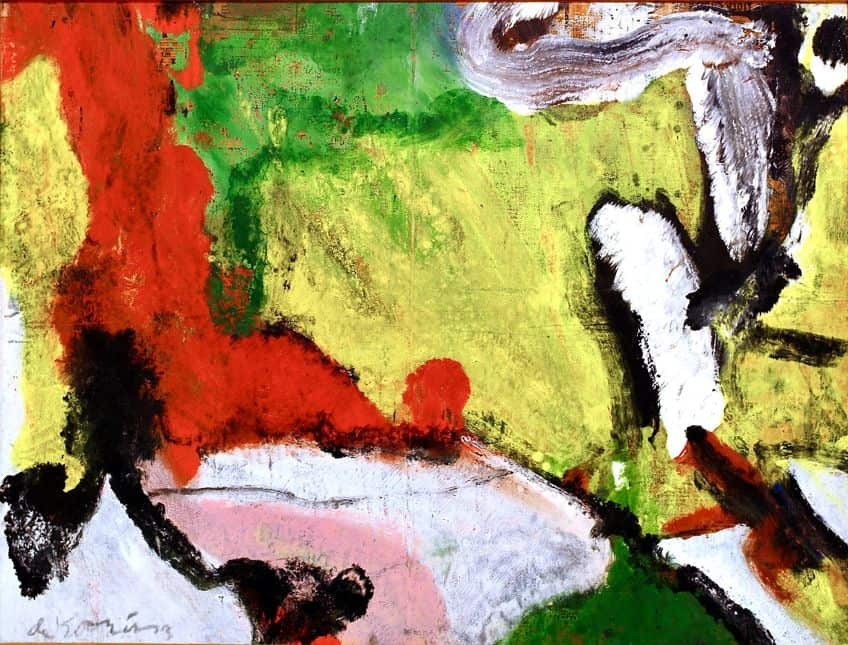
Abstract Expressionism
Abstract Expressionism emerged in the United States in the 1940s and is characterized by a focus on abstraction and the use of non-representational forms to convey emotions and ideas. Artists associated with this movement often employed large canvases, bold brushstrokes, and bright colors to create works that were highly expressive and emotionally charged.
Notable Abstract Expressionist artists include Jackson Pollock (1912-1956), Mark Rothko (1903-1970), and Willem de Kooning (1904-1997).
Neo-Expressionism
Neo-Expressionism emerged in the 1980s as a reaction against the minimalist and conceptual art movements that dominated the art world at the time. Artists associated with this movement often employed bold colors, gestural brushstrokes, and a focus on the human figure to create works that were highly expressive and emotionally charged. Notable Neo-Expressionist artists include Anselm Kiefer (1945 – Persent), Julian Schnabel (1951 – Persent), and Jean-Michel Basquiat (1960 – 1988).
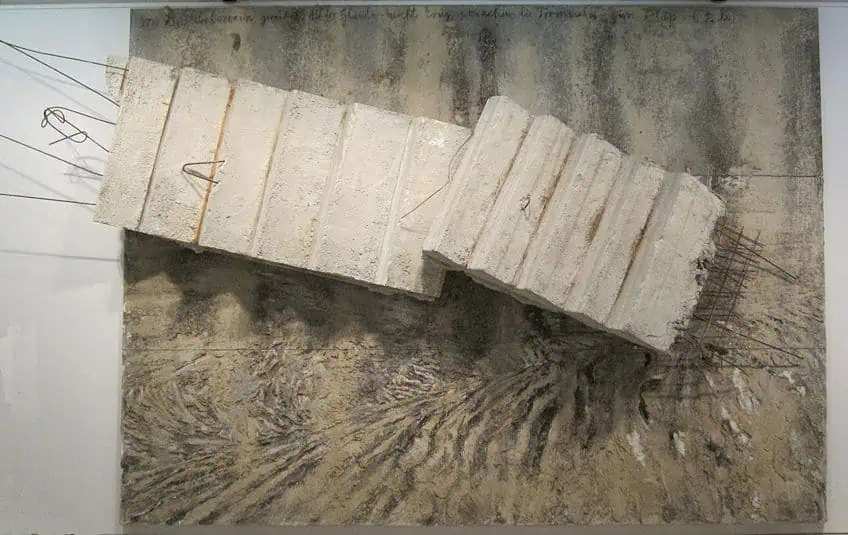
Figurative Expressionism
Figurative Expressionism is a type of expressionism that emerged in the mid-20th century and is characterized by a focus on the human figure. Artists associated with this movement often used distorted shapes and exaggerated emotions to convey the inner experiences of their subjects.
Notable Figurative Expressionist artists include Francis Bacon (1909 – 1992), Lucian Freud (1922 – 2011), and Leon Golub (1922 – 2004).
Deep Dive Into Notable Expressionism Artworks
Expressionist artworks often have layered meanings and symbolism. In this section of the article, we will look at two famous artworks that came out of this expressive painting movement: The Scream (1893) by Edvard Munch and Starry Night (1889) by Vincent van Gogh

Starry Night (1889) by Vincent van Gogh
| Artist | Vincent van Gogh (1853 – 1890) |
| Artwork Date | 1889 |
| Medium | Oil on canvas |
| Dimensions (cm) | 74 x 92 |
| Location | The Museum of Modern Art, New York City, United States |
Vincent van Gogh painted Starry Night in 1889 during his stay at the Saint-Paul-de-Mausole asylum in France. At the time, Van Gogh was struggling with mental illness, including episodes of severe depression, anxiety, and delusions.
However, despite his struggles, Van Gogh continued to paint, finding solace in his art.
Visual Analysis
Vincent van Gogh’s Starry Night is a masterpiece of post-impressionist painting. The composition is dominated by a dramatic night sky, which takes up most of the canvas. The sky is filled with swirling, pulsing stars and a bright crescent moon. In the foreground, there is a small village with tall cypress trees and a church steeple.
The painting’s composition is balanced by the contrast between the dark earth tones of the village and the bright, swirling colors of the sky.
Van Gogh’s use of color and light in this painting is striking and powerful. The swirling, pulsing stars and clouds are rendered in a vivid, almost electric blue, which contrasts sharply with the warm, earthy tones of the village below. The crescent moon and bright stars add a sense of depth and movement to the composition, while the warm yellow light of the windows in the village suggests a sense of warmth and comfort amidst the darkness.

The texture of Starry Night is highly expressive and adds a sense of movement and energy to the composition. The thick, bold brushstrokes create a swirling, undulating effect that suggests the motion of the stars and clouds in the night sky. The rough, textured surface of the canvas adds to the painting’s sense of depth and texture, making it feel almost like a three-dimensional object. The perspective in Starry Night is highly stylized, with a flattened, two-dimensional effect that emphasizes the painting’s expressive qualities.
The exaggerated lines of the cypress trees and the church steeple give the painting a sense of movement and energy, while the swirling stars and clouds suggest a dynamic, ever-changing universe.
Overall, Starry Night is a highly symbolic and expressive work of art. The painting is often interpreted as a reflection of Van Gogh’s inner turmoil and his intense connection to nature and the universe. The swirling, pulsing stars, and clouds suggest a sense of chaos and turmoil, while the warm, comforting light of the village windows suggests a sense of hope and comfort in the midst of darkness.
The Scream (1893) by Edvard Munch
| Artist | Edvard Munch (1863 – 1944) |
| Artwork Date | 1893 |
| Medium | Oil, tempera, pastel, and crayon on cardboard |
| Dimensions (cm) | 91 × 73.5 |
| Location | National Gallery and Munch Museum, Oslo, Norway |
Edvard Munch’s iconic painting, The Scream, was created in 1893, during a period of significant social, political, and cultural upheaval in Europe. At the time, Norway, where Munch was born, was undergoing a rapid transformation from a rural, agrarian society to a more urban, industrial one, and many people were struggling to adapt to the changes. Munch himself had a troubled personal life, with a family history of mental illness and a series of personal tragedies that left him feeling isolated and alone. The painting was also created during a period of significant artistic experimentation, with artists across Europe exploring new styles and techniques in response to the changing world around them.
Munch was part of a larger movement known as Symbolism, which sought to express emotional and psychological truths through art.
Visual Analysis
Edvard Munch’s The Scream is a highly iconic painting that features a central figure in the foreground, depicted as a human figure with a face contorted in a scream. The figure is situated on a bridge with a railing, and the background is filled with a chaotic, swirling landscape that seems to echo the figure’s emotional turmoil. The composition of the painting is highly asymmetrical, with the figure placed off-center and the bridge and railing extending outwards to the right. The overall effect is one of tension and unease, as if the entire scene is about to tip over into chaos.
Color and light are integral to the emotional impact of The Scream. The sky is rendered in an unnatural, almost sickly shade of yellow-orange, which contrasts starkly with the dark blues and greens of the landscape.
This creates a sense of unease and suggests that the world is out of balance. The figure’s face is also painted with an otherworldly, almost ghostly pallor, which suggests that he is in a state of intense distress or anxiety. The overall effect of the color and light in the painting is one of disorientation and confusion, which perfectly captures the emotional state of the figure in the foreground. The texture is highly expressive and helps to convey the intensity of the emotions on display. The brushstrokes are rough and jagged, suggesting that the figure is in the grip of a powerful emotional storm. The texture also creates a sense of depth and dimensionality, with the foreground figure seeming to emerge from the painting’s surface.
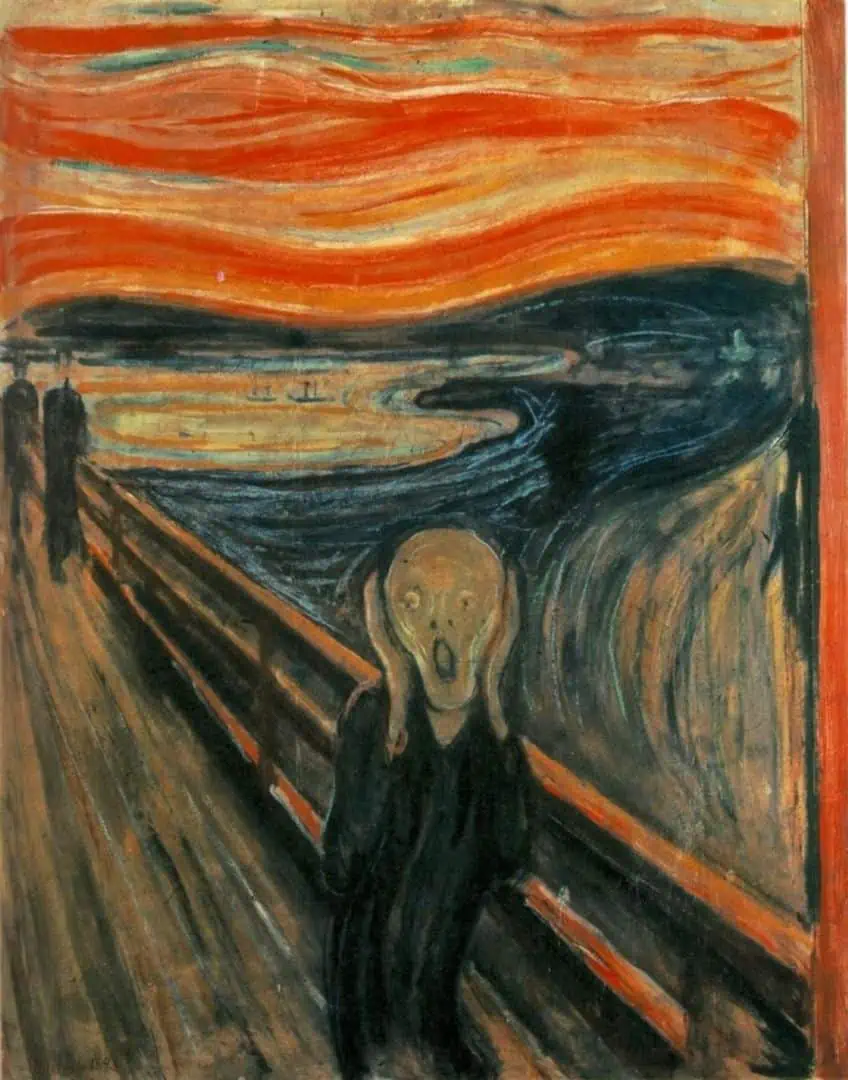
The perspective in the painting is highly unusual, with the figure in the foreground depicted in a distorted, almost caricatured form. This creates a sense of unease and suggests that the figure is not quite human, but rather a representation of some deeper, darker emotion or experience. The perspective also serves to emphasize the figure’s isolation, with the bridge and railing extending outwards to the right and the background landscape seeming to stretch out to infinity.
The symbolism of The Scream is deeply complex and has been the subject of much interpretation and analysis.
At its core, the painting seems to be a powerful expression of the human condition, with the figure in the foreground representing the intense emotions and anxieties that we all experience at times. The bridge and railing may symbolize a boundary or threshold, beyond which lies the unknown and the unpredictable. The overall effect of the painting is one of intense emotion and raw, unfiltered expression, making it a masterpiece of modern art.
Overall, the importance of Expressionism in the art world lies in its emphasis on emotional expression and individual experience, and its rejection of traditional artistic conventions. The movement paved the way for other avant-garde artistic styles, and had a significant impact on the development of modern art, architecture, literature, music, and film. Today, Expressionism remains a vital and influential force in the art world, inspiring artists and audiences alike with its bold and passionate approach to artistic expression.
Take a look at our Expressionism webstory here!
Frequently Asked Questions
What Is Expressionism?
In conclusion, Expressionism was a revolutionary art movement that emerged in Germany at the start of the 20th century. It was a response to the prevailing academic art forms that emphasized objectivity and realism. The movement was catalyzed by the work of the Die Brücke and Der Blaue Reiter groups, who rejected traditional styles and sought to capture raw emotions and energy. Despite initial resistance, Expressionism gained popularity and acceptance due to its reflection on the changing social and political climate of the time, and its impact on various art forms.
How Are Fauvism and the Expressionist Movement Linked?
While Fauvism and Expressionism were distinct movements with their own unique styles and concerns, they were deeply interconnected. Fauvism’s emphasis on color and expressiveness paved the way for Expressionism’s exploration of emotion and the psyche, and both movements rejected traditional forms and techniques in favor of new, experimental approaches to painting. Despite their similarities, however, Fauvism and Expressionism differed in their subject matter, use of form, and emotional tone, creating two distinct and influential art movements that continue to inspire artists to this day.
What Are the Characteristics of Expressionist Paintings?
Overall, Expressionism is characterized by its emphasis on subjective emotions and inner experiences, as well as its use of bold colors, distorted shapes, exaggerated emotions, and symbolism. The movement had a profound impact on modern art, and its influence can be seen in the work of many artists across a variety of styles and genres.
What Led to the Start of the Expressionism Years?
The movement emerged as a response to the overall traditional artistic styles of the time, such as Impressionism and academic art, which were considered to be too shallow and focused on superficial beauty. The social and political upheaval of the time, including World War I and the rise of industrialization, also contributed to the development of Expressionism. Artists felt a need to respond to these changes and to express their own subjective experiences and emotions, resulting in a new art form that rejected traditional rules of composition and representation. Expressionism became a way for artists to explore the deeper, darker aspects of the human psyche, and to convey the anxieties and fears of a changing world.
What Is Abstract Expressionism Art?
Abstract Expressionism is a post-World War II art movement that emerged in the United States in the late 1940s and early 1950s. It is characterized by its emphasis on spontaneous, gestural brushwork and the use of abstraction to convey emotion and personal expression. Rather than representational images or recognizable subjects, Abstract Expressionist artists created non-representational works that emphasized the physical act of painting, with drips, splatters, and other marks that conveyed a sense of energy and movement. This movement is often associated with the names of influential artists such as Jackson Pollock, Willem de Kooning, and Mark Rothko.
What Is Neo-Expressionism Art?
Neo-Expressionism is an art movement that emerged in the late 1970s and early 1980s as a reaction against the Minimalism and Conceptual art of the previous decade. It is characterized by a return to figurative representation and the use of bold, gestural brushstrokes and intense colors to convey a sense of emotional intensity and immediacy. Neo-Expressionist artists often drew inspiration from art historical traditions, such as German Expressionism and the work of the Abstract Expressionists, but also incorporated elements of popular culture and mass media into their works. The movement is associated with artists such as Julian Schnabel, Anselm Kiefer, and Jean-Michel Basquiat, among others.
Nicolene Burger, a South African multimedia artist and creative consultant, specializes in oil painting and performance art. She earned her BA in Visual Arts from Stellenbosch University in 2017. Nicolene’s artistic journey includes exhibitions in South Korea, participation in the 2019 ICA Live Art Workshop, and solo exhibitions. She is currently pursuing a practice-based master’s degree in theater and performance. Nicolene focuses on fostering sustainable creative practices and offers coaching sessions for fellow artists, emphasizing the profound communicative power of art for healing and connection. Nicolene writes blog posts on art history for artfilemagazine with a focus on famous artists and contemporary art.
Learn more about Nicolene Burger and about us.
Cite this Article
Nicolene, Burger, “Expressionism Art – Expressionist Movement Characteristics.” artfilemagazine – Your Online Art Source. May 16, 2023. URL: https://artfilemagazine.com/expressionism-art/
Burger, N. (2023, 16 May). Expressionism Art – Expressionist Movement Characteristics. artfilemagazine – Your Online Art Source. https://artfilemagazine.com/expressionism-art/
Burger, Nicolene. “Expressionism Art – Expressionist Movement Characteristics.” artfilemagazine – Your Online Art Source, May 16, 2023. https://artfilemagazine.com/expressionism-art/.



